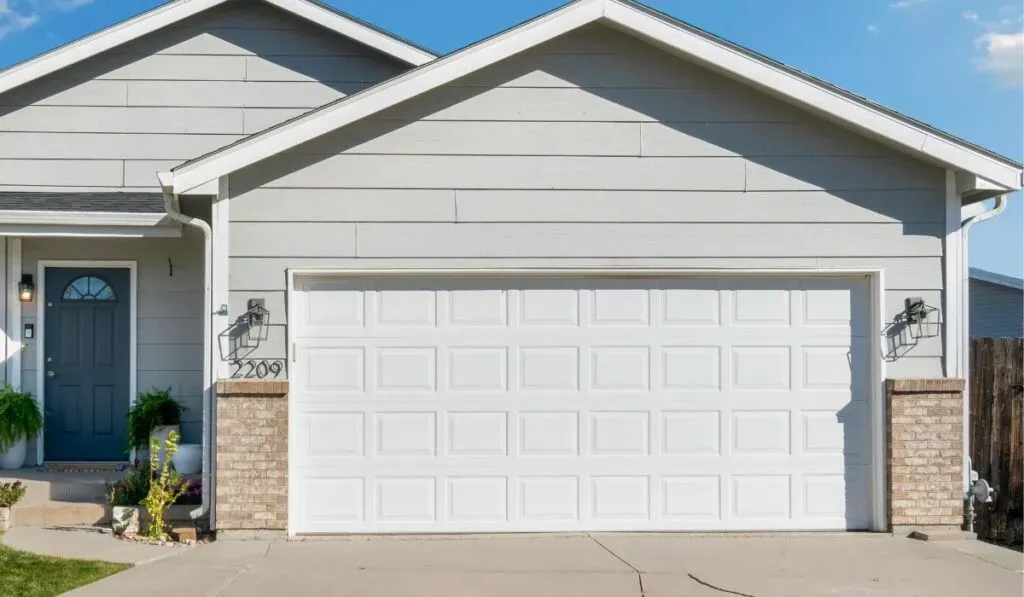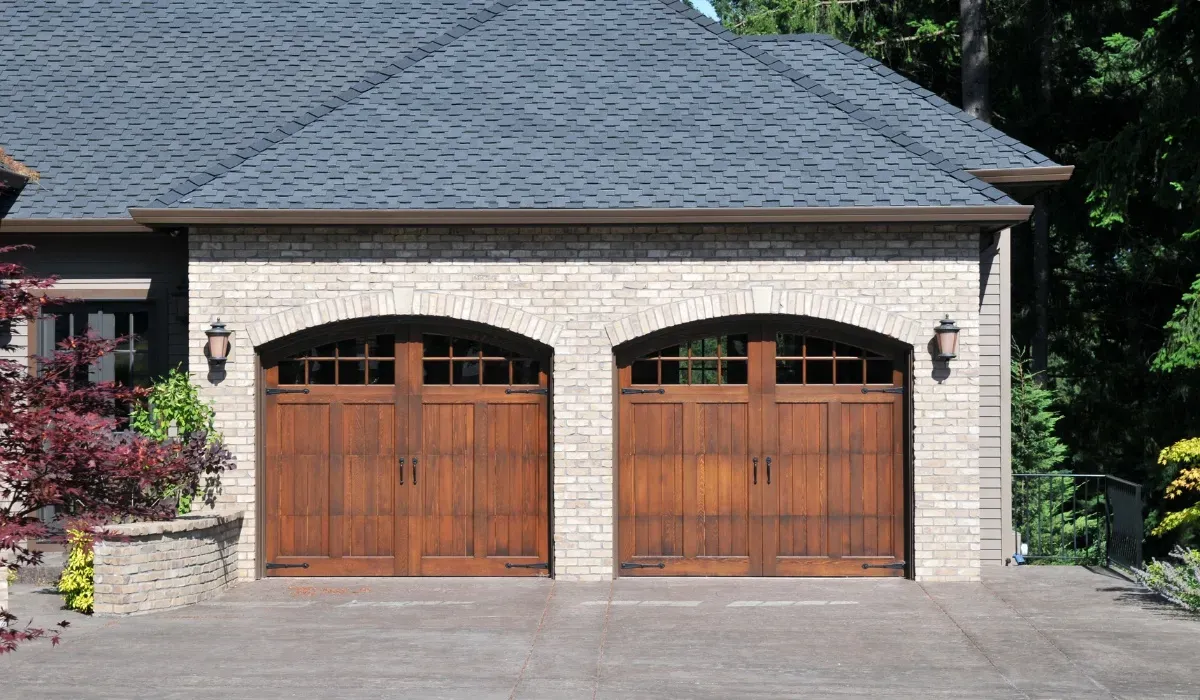Standard garage door sizes in Canada are key for homeowners looking to replace or install doors that fit common single and double garages, such as 8×7, 9×7, and 16×7 feet.
Understanding residential garage door sizes along with rough and finished openings, headroom, backroom, and sideroom measurements helps avoid pitfalls, especially in older homes, while offering options for custom doors and metric sizes.
Understanding Standard Garage Door Dimensions
Picking the right garage door size matters. In Canada, most homes use doors with certain common widths and heights. Usually, the widths are 8 feet (2.44 meters), 9 feet (2.74 meters), or 16 feet (4.88 meters). Heights tend to be around 7 feet (2.13 meters). Knowing these garage door measurements helps you pick a door that fits just right.
Here’s a quick look at common sizes:
- Widths: 8 ft, 9 ft, 16 ft
- Heights: mostly 7 ft
This info works great if you want standard residential garage doors in Canada.
Common Single Car Garage Door Sizes
Single car garage doors fit one car with enough space to get in and out easily. The two usual sizes are:
- 8×7 Feet: Good for smaller cars or compact rides.
- 9×7 Feet: Slightly wider for bigger sedans or small SUVs.
These sizes give enough room without wasting space.
Common Double Car Garage Door Sizes
Double car garage doors handle two cars side by side. The most popular size is:
- 16×7 Feet: Big enough for trucks, SUVs, and most family vehicles.
With this size, you won’t have to squeeze your cars in or worry about door clearance.
Garage Door Size Considerations for RVs & Larger Vehicles
If you have an RV or a larger vehicle, your garage door needs to be bigger. Here’s what usually works:
- Minimum height: About 10 feet (3.05 meters)
- Minimum width: Around 14 feet (4.27 meters)
This size clears tall parts like roof air conditioners or antennas on your RV. So, don’t pick a standard door if your vehicle is oversized.
Measuring Your Garage Door Opening
Getting your garage door measurements right helps you pick the perfect size. Here’s how to do it:
- Measure the Width: Use a tape measure to find the distance between the inside edges of the rough opening.
- Measure the Height: Check from the floor up to the top edge of the rough opening.
- Check Headroom: Measure from the top of the finished opening up to where ceiling beams start.
- Measure Sideroom: Look for space on both sides of your door, between wall studs and anything blocking.
- Calculate Backroom: Measure from inside face of garage door opening back into your garage.
Measuring Finished Opening vs Rough Opening
You’ll see two terms a lot: rough opening size and finished opening size. They’re not the same.
- Rough Opening Size is the frame made by wall studs before any drywall or trim goes on.
- Finished Opening Size adds drywall, trim, or other finish materials around that frame.
Usually, installers use rough openings for sizing because it shows real space for doors and tracks.
This difference matters. Older homes often have uneven walls, so knowing which size you need stops you from buying a wrong door that won’t fit right.
Accurately Measuring Garage Door Width
Width matters a lot—it decides if your car fits easily without scratches or scrapes.
- Single-car garage doors usually come in 8 feet (96 inches) or 9 feet (108 inches).
- Double-car doors often measure 16 feet (192 inches).
How to measure width:
- Take three measurements: bottom, middle, and top across your rough opening.
- Use the smallest measurement. Walls aren’t always perfectly straight.
Accurately Measuring Garage Door Height
Height affects clearance under beams and where tracks go overhead.
- Standard height is usually 7 feet (84 inches).
- Some garages might need 8-foot tall doors for bigger vehicles.
Here’s what to do:
- Measure from floor surface up to header beam at several spots.
- Watch for sloped floors—they can change height needs.
- If you use metric, common heights are around 2130 mm or 2440 mm depending on vehicle type.
Getting this right avoids costly fixes when installing later.
The Importance of Track Radius
Track radius means how sharp vertical tracks curve into horizontal ones above your head when open:
- Having the right radius keeps doors rolling smoothly without sticking or making noise.
Common specs include:
- Standard radius is about a 15-inch curve.
- Low-headroom kits use tighter curves near 10 inches.
Measuring vertical track clearance shows if you need these special kits—especially in older homes with low ceilings.
Factors Influencing Your Garage Door Size Choice
Picking the right garage door size is about more than just width and height. You also need to think about garage door thickness, insulation, materials, and energy efficiency.
Garage doors come in different thicknesses. Thicker doors usually have foam insulation inside. This foam helps with thermal resistance. The thickness of foam insulation changes the door’s R-value, which measures how well it stops heat from passing through. A higher R-value means better insulation. That keeps your garage warmer in winter and cooler in summer.
Materials for garage door panels vary too. Steel, aluminum, wood, and fiberglass are common choices. Steel doors with foam cores are strong and save energy. If your garage attaches to your home or you work there, an insulated door helps lower heating costs.
Energy efficient garage doors combine good materials and solid insulation. They keep your garage comfy and cut down on utility bills. So when you pick a size, think about space and how well the door handles temperature changes.
Garage Size and Number of Vehicles
How many vehicles you have affects your garage door size a lot.
- Single-car garages usually need a door about 8 feet wide by 7 feet tall.
- Double-car garages need a bigger door—around 16 feet wide by 7 feet tall.
Big trucks or SUVs might need wider or taller doors to get in without scraping.
Vehicle parking space requirements should give enough room to open car doors inside the garage. Also, you want space to walk around cars easily.
If you own more than one vehicle or larger vehicles, exploring our residential garage door options can help avoid tight fits.
Considering Storage Needs Within the Garage

Storage needs matter when picking a garage door size because they affect the inside space beyond just parking.
You might want extra storage if you keep tools, bikes, lawn gear, or seasonal stuff in the garage. That means thinking about floor space plus how tall the area is behind your door.
Garage storage solutions like wall racks or shelves overhead save space but need enough headroom above the door. This links closely to track radius and backroom size when installing.
So before buying a new door size, think about what you’ll store later on so you don’t run out of room too fast.
Matching Garage Door Size to Your Home’s Architecture
A good-sized garage door makes your home look better by fitting its style—not overpowering it.
Here’s what matters:
- The outside should look balanced; big doors can look odd on small houses.
- Styles like Craftsman or Colonial go well with classic paneled doors in standard sizes.
- Modern homes may fit wider glass-paneled sectional doors that look sleek but still fit nicely.
Picking matching colors and hardware finishes also helps tie everything together between house design and new garage doors.
Two Single Doors vs One Double Door: Weighing the Options
Choosing between two single car garage doors or one double door depends on how you want to use the space as well as size needs:
Two Single Doors
- Each is usually 8×7 ft up to 9×7 ft.
- You can open just one side when needed.
- Offers better airflow than one big opening sometimes.
One Double Door
- Starts around 16×7 ft wide; height is like singles.
- Easier to move big stuff through one wide opening.
Both affect the driveway looks differently—two singles break up the front visually; doubles give a cleaner front line.
Custom Garage Door Options
Standard garage doors fit most homes. But sometimes, they just don’t work right. Custom garage doors solve that problem. They fit openings that are unusual or bigger than normal. Need oversized garage doors for tall or wide vehicles? Custom size garage doors handle it all.
You can change width, height, materials, and style. This helps your door match your home’s look and needs. Want extra space or a taller door? No problem. Designing your custom garage door with Gulliver Garage Doors means you get help at every step from our custom garage door solutions. From measuring to picking materials, experts make sure your door fits perfectly and lasts long.
The Benefits of Custom-Made Garage Doors
Custom-made garage doors offer more than just size options. Here’s what you get:
- Enhanced appearance: Pick styles, colors, and finishes that make your home look better.
- Architectural style: Choose designs like carriage houses or modern panels to match your house.
- Energy efficient garage doors: Many have foam insulation that saves energy.
- Thermal insulation value (R-value): Higher R-values keep your garage warmer or cooler.
- Foam insulation thickness: Options range from 1 inch to 2 inches thick for better heat control and less noise.
Custom doors save energy and make your home feel nicer. Plus, they look great too.
Addressing Common Garage Door Issues
Older homes, especially in Edmonton and other parts of Ontario, can cause problems when you replace garage doors.
Here are some things to watch out for:
- Rough vs finished openings: Old garages might have uneven frames. This makes fitting modern doors tricky without fixes.
- Backroom space: Some older garages don’t have enough depth behind the door opening. That can limit where tracks go or need special kits.
- Sideroom clearance: Thin sidewalls might mean you need special hardware so tracks don’t hit walls or stuff stored nearby.
These issues can slow down your installation if you don’t check them early.
If you live in an older house here, think about getting advice from someone who knows these common problems before buying a new door.
Accessing Garage Door Installation Manuals
Installing garage doors right matters a lot for safety and meeting Canadian rules; check out our professional garage door installation for expert guidance. Most brands give detailed installation manuals with step-by-step guides made for each model.
Here are some tips when installing:
- Measure twice before starting.
- Check local building codes where you live.
- Use the tools listed in the manual.
- Follow safety steps carefully as you work.
Gulliver Garage Doors: Your Partner for Garage Door Solutions
Picking the right garage door helps keep your home safe and looking good. If you need garage door installation in Canada, replacement, or repairs, it’s smart to get pro help. We work with residential garage doors that fit Canadian homes just right. Our team follows local building codes and uses strong materials to make sure your door lasts.
A good installation protects your door and your home. Our garage door specialists know how to do the job right. We give you clear garage door installation manuals that explain each step. Plus, we follow all local building codes for garage doors so everything is safe and legal.
If you have questions during or after the install, just contact us anytime.

